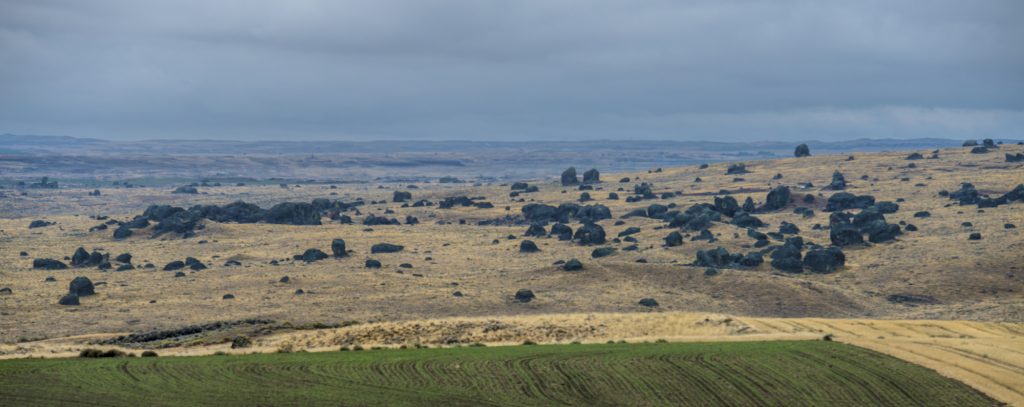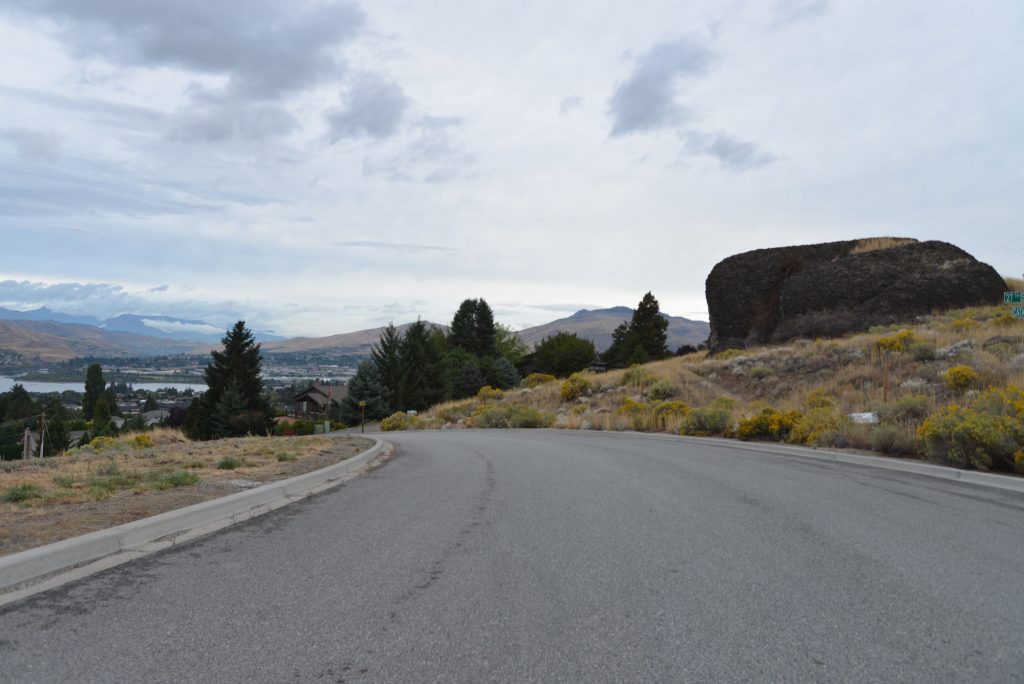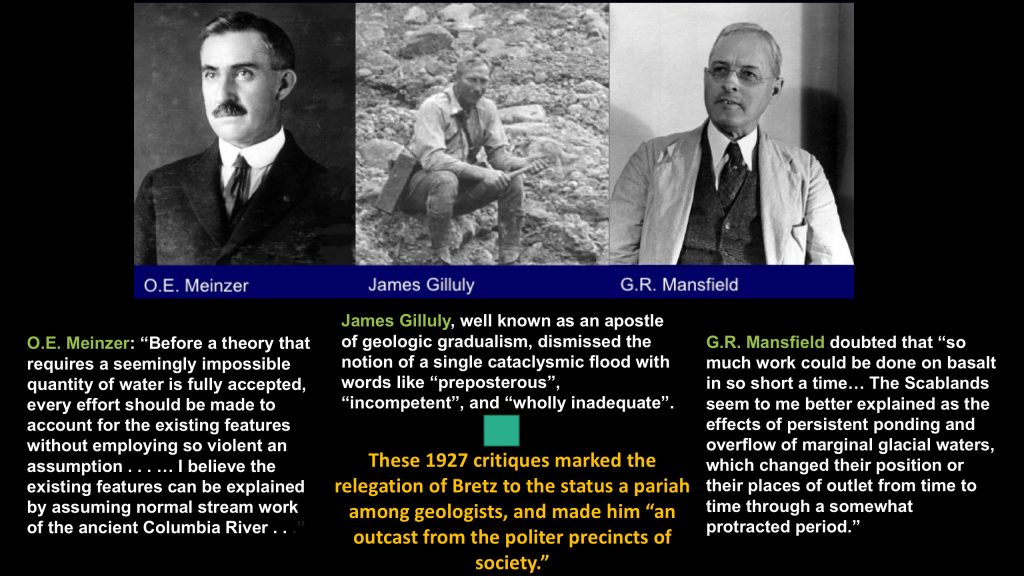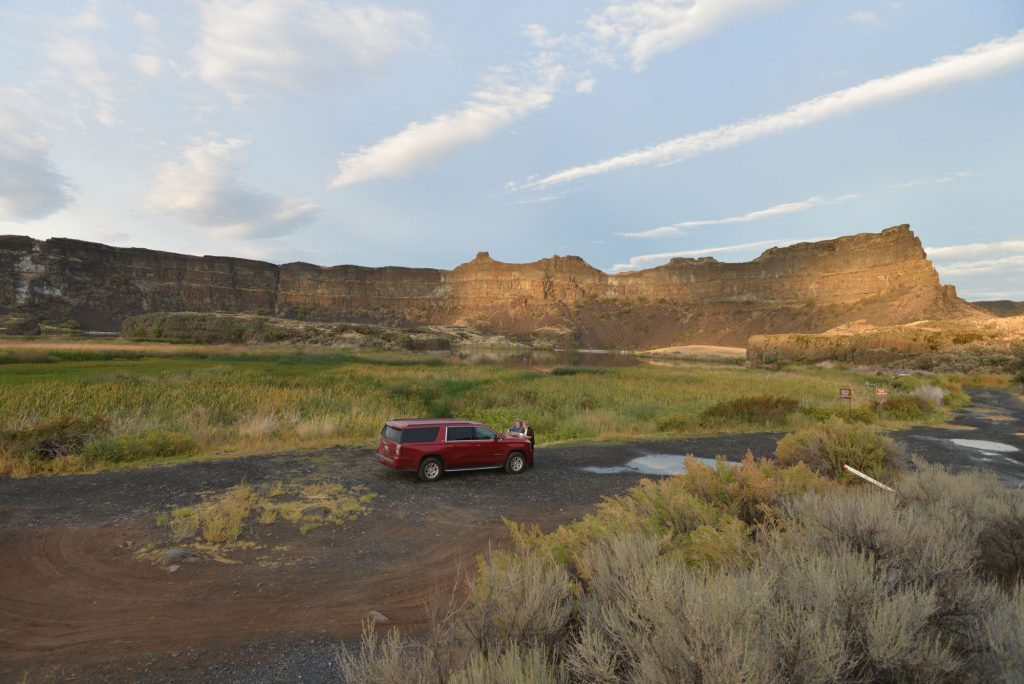Why Science Should Cherish Its Rebels
by Graham Hancock
Published 30th April 2017

Graham Hancock with catastrophist theorist Randall Carlson at Dry Falls -- a fossilised waterfall of enormous size cut by the waters of Bretz's flood and left as we see it now when the flood had run its course. Photo by Santha Faiia.
There is fierce disagreement amongst mainstream scientists – a disagreement that also divides alternative researchers – around what happened to the Earth, and to humanity, in the closing millennia of the last Ice Age between 12,800 and 11,600 years ago. Marked by intense cold, global floods and extinctions of animal species, this 1200-year interval is known to geologists as the Younger Dryas. Many of the leading investigators are convinced the agent of the mysterious earth changes, and of the extinctions, was a comet that the struck the North American ice cap with globally cataclysmic effects. But their “Younger Dryas Impact Hypothesis” is still regarded as controversial by others who have sought, more than once in the scientific literature, to declare it “disproved” only to be confronted by compelling new evidence that further strengthens the case. In this article, Graham Hancock shows how scientists consistently suppress and marginalise new knowledge that conflicts with established positions and argues that a paradigm shift is underway – a shift that will require us to reconsider everything we’ve been taught about the peopling of the Americas and about the very origins of civilization.
In March 2017 theNational Geographic Society and the Smithsonian Institution, those bastions of scientific orthodoxy, highlighted the remarkable achievements of two scientific rebels, one retired and the other deceased, confessing that multiple injustices had been done to both and that the “toxic” way in which they had been treated by their professional colleagues had “poisoned” scientific progress.
In the case of The Smithsonian the focus was on Canadian archaeologist Jacques Cinq-Mars, ostracised in the 1990’s because his excavations at Bluefish Caves in the Yukon “directly challenged mainstream thinking” with evidence that the peopling of the Americas had begun many thousands of years earlier than had previously been thought.1
We will have more to say about the case of Dr Cinq-Mars in the second half of this article.
Meanwhile for National Geographic the rebel of choice in 2017 was US geologist J. Harlen Bretz, condemned to pariah status in the 1920’s for daring to propose that a gigantic flood had scoured the “scabland” of America’s Pacific Northwest near the end of the last Ice Age.2 It was an idea that contradicted the consensus view of scientists at the time that geological transitions were always slow and gradual – a view in which there was no place for sudden and cataclysmic earth changes.
Bretz died in 1981, soon after Cinq-Mars began his paradigm-busting excavations in the Yukon. The two men did not know one another and worked in entirely different fields. What they have in common, however, and the reason that the mainstream science press which once attacked them now sings their praises, is that both spent decades being vilified by their scientific peers but were ultimately proved right.
Here is Bretz, writing in 1928 after one of his field trips across Washington State in the Pacific Northwest of the US: “No one with an eye for landforms can cross eastern Washington in daylight without encountering and being impressed by the ‘”scabland’.” Like great scars marring the otherwise fair face of the plateau are these elongated tracts of bare, or nearly bare, black rock carved into mazes of buttes and canyons. Everybody on the plateau knows scabland. It interrupts the wheat lands, parcelling them out into hill tracts less than 40 acres to more than 40 square miles in extent. One can neither reach them nor depart from them without crossing some part of the ramifying scabland. Aside from affording a scanty pasturage, scabland is almost without value. The popular name is an expressive metaphor. The scablands are wounds only partially healed – great wounds in the epidermis of soil with which Nature protects the underlying rock.
“With eyes only a few feet above the ground the observer today must travel back and forth repeatedly and must record his observations mentally, photographically, by sketch and by map before he can form anything approaching a complete picture. Yet long before the paper bearing these words has yellowed, the average observer, looking down from the air as he crosses the region, will see almost at a glance the picture here drawn by piecing together the ground-level observations of months of work. The region is unique: let the observer take the wings of the morning to the uttermost parts of the earth: he will nowhere find its likeness.”3
By 1928 Bretz was an experienced and highly credentialed field geologist. Born in 1882, he’d started his career as a high school biology teacher in Seattle but spent most of his spare time exploring the geology of Puget Sound. Although he didn’t have a geology degree at the time, he succeeded in getting several articles on his findings published in scientific journals.4 In 1911 he enrolled at the University of Chicago to pursue a doctorate in geology. He graduated summa cum laude in 1913 and immediately thereafter returned to Seattle where he accepted a position as assistant professor of geology at the University of Washington.5 He had difficulties with the attitudes of other teaching staff there (he later described them as “stick-in-the-muds”6) and by 1914 he was back at the University of Chicago, initially as an instructor but soon afterward as an assistant professor.7
The first field trip Bretz made to the scabland of eastern Washington was in 1922. By this point, as a result of his earlier work, he was fully informed about the Ice Age in all its dimensions and more aware than most other geologists that immense ice sheets up to two miles deep, had covered North America for the best part of 100,000 years until the ice melted dramatically somewhere between 15,000 and 11,000 years ago. Thus when he saw huge numbers of erratics – giant boulders that didn’t belong naturally in the area but had clearly been brought in from elsewhere – he was inclined to assume that they might have travelled here in icebergs carried on some great glacial flood. This impression was strengthened when he explored Grand Coulee and Moses Coulee – gigantic channels gouged deeply in the earth – and visited the Quincy Basin at the southern end of Grand Coulee where he found the whole 600-square-mile depression filled up to a depth of 400 feet with small particles of basalt debris. He couldn’t help but wonder, “where had all the debris come from, and when?”8 Again the answer that presented itself to him was a flood.
Bretz was back in the Scablands in 1923 for three months of exploration and it seems to have been during this field trip that his later views – namely that “some spectacular hydrological event . . . had begun in this region, then abruptly stopped”,’ really began to take shape.9
In the November-December 1923 issue of the Journal of Geology Bretz published a paper summarizing his findings. To understand the somewhat defensive tone of the paper it is necessary to keep in mind the prevailing geological doctrine of the time, the principle known as “uniformitarianism”. This is the assumption that existing processes, acting as at present, are sufficient to account for all geological changes. Integral to it is the parallel assumption of gradualism, namely that “the present is the key to the past” and that the rate of change observable today is an accurate guide to rates of change that prevailed in the past.
Such ideas, which had acquired the status of unchallengeable truth by the 1920’s, had themselves arisen from the needful – indeed essential – overthrow of the old religious belief in creationism and the notion that God whimsically intervened in the earth’s history by ordaining cataclysms such as the Biblical Flood. In righteous opposition to these thoughts of supernatural creation and destruction, uniformitarianism seemed a profoundly rational response that saw only the forces of nature at work upon the earth over periods of millions, or indeed billions of years.
‘Mountains had not been built overnight, but had risen slowly, imperceptibly over time. Likewise had fantastic geological features such as the Grand Canyon been eroded by the flow of rivers over many millions of years.’10
Bretz was an eminently rational man, and certainly no religious dogmatist, yet, as his biographer John Soennichsen notes, “while hiking through the hot, dry, ragged world of the Scablands, everything he had seen pointed not to a slow, uniform change over time but to a catastrophe, a sudden release of colossal quantities of water that had quickly washed away the loessial topsoil and then carved deeply into the basalt rock beneath.”11
The problem was – where had all this water come from? It was well understood that at the margin of the north American ice sheets there must have been some melting – as one indeed sees at the edges of all glaciers today. But such melting could hardly explain the magnitude of the erosive changes that were visible in the field. As Bretz noted in his 1923 paper: “The writer confesses that during ten weeks of study of the region, each newly examined scabland tract reawakened a feeling of amazement that such huge streams could take origin from such small marginal tracts of an ice sheet, or that such an enormous amount of erosion, despite high gradients, could have resulted in the very brief times these streams existed. Not River Warren, nor the Chicago outlet, not the Mowhawk channel, nor even Niagara Falls and Gorge itself approach the proportions of some of these scabland tracts and their canyons. From one of these canyons alone [Upper Grand Coulee] 10 cubic miles of basalt was eroded by its glacial stream.”’12
Concluding the paper, and moving towards the profoundly heretical and anti-uniformitarian idea that would soon get him into a great deal of trouble, namely that a single cataclysmic flood sustained only for a very short period had been responsible for all the devastation he had witnessed, Bretz wrote: “Fully 3,000 square miles of the Columbia plateau were swept by the glacial flood, and the loess and silt cover removed. More than 2,000 square miles of this area were left as bare, eroded, rock-cut channel floors, now the scablands, and nearly 1,000 square miles carry gravel deposits derived from the eroded basalt. It was a debacle which swept the Columbia Plateau.”’13
In other words, as Bretz’s biographer summarizes, the geologist now believed that the features he had documented “could only have been created by a flood of unimaginable proportions, possibly the largest flood in the history of the world”.’14

Photos by Santha Faiia. This colossal glacial erratic, now perched high up on the valley side above the town of Wenatchee, Washington state, was brought here in an iceberg the size of an oil tanker carried on a raging flood hundreds of feet deep.
Pariah
The reaction of the geological establishment was one of stunned, embarrassed silence. To have strayed so far from the doctrine of uniformitarianism could only mean that Bretz must have gone mad. David Alt, Professor Emeritus of Geology at the University of Montana, describes one of the lectures that Bretz gave in which he expounded on the ideas in his 1923 paper: “The geologists . . . were aghast in the same way that a roomful of physicists would be upon hearing a colleague explain how he had made a perpetual motion machine out of old popsicle sticks. Physicists had all learned very early of the futility of perpetual motion machines, and no properly educated geologist was supposed to traffic in catastrophes of any sort.’15
Alt describes an old professor of his own undergraduate days who had been a student sitting in the audience when Bretz read his 1923 paper. It seems the professor did a hilarious impersonation of Bretz “pounding on the podium with both fists and stomping on the floor as he used vivid language and gestures to convey his idea of a catastrophic flood to his horrified audience.”16
Quite apart from the theatricals, the geologists were shocked to hear Bretz invoke: “a sudden catastrophe to explain the Scablands of eastern Washington. In their view this was a reversion to the unscientific thinking of some 125 years before. To this day, most geologists consider it nothing less than heresy to invoke a catastrophic explanation for a geologic event. So Bretz stepped off the edge of a very long limb when he suggested that a great flood had eroded the Scablands . . . . [It made] him a pariah among geologists, an outcast from the politer precincts of society.”’17
The outcast did not give up, however. On the contrary, he doggedly continued with his research, bringing down ever more controversy on his own head in the process but believing that the facts, ultimately, would vindicate him.
The crunch came on 12 January 1927 when Bretz was ambushed by a lynch mob of his colleagues at a lecture he’d been invited to give to the Geological Society of Washington in the Cosmos Club, Washington DC. Bretz was by now calling “his” flood the “Spokane Flood” (after the town of Spokane) and liked to refer to the ice sheet from which it had emerged as the “Spokane ice sheet” (neither term is used today but Bretz’s Spokane ice sheet was, effectively the southern part of that great late Pleistocene ice sheet now known as the “Cordilleran”). He believed that large parts of it must have melted with extraordinary rapidity, because “the volume of water was very great, almost incredibly great . . .… In spite of high gradients to draw it off, the pre-existing valleys first entered were inadequate to carry it all, and the flood spread widely in a complicated group of anastomosing routes.”’18
W.C. Alden, then the Chief of Pleistocene Geology with the profoundly conservative US Geological Survey, objected to “the idea that all the channels must have been developed simultaneously in a very short time” and took great offence at “the tremendous amount of water” postulated by Bretz.19 “It seems to me impossible,” Alden protested, “that such part of the great ice fields as would have drained across the Columbia Plateau could, under any conditions, have yielded so much water as is called for in so short a time.”20 He admitted that he had never visited the scablands himself but felt sure that a uniformitarian explanation was what was required. “The problem would be easier,” he opined, “if longer time and repeated floods could be allotted to do the work.”21
James Gilluly, well known as an apostle of geologic gradualism, dismissed the notion of a single cataclysmic flood with words like “preposterous”, “incompetent”, and “wholly inadequate”.22 He found nothing in Bretz’s evidence to exclude his own preferred solution, namely that multiple smaller floods had been involved and that these would have been “of the order of magnitude of the present Columbia’s, or at most a few times as large”.’23
Likewise G.R. Mansfield doubted that “so much work could be done on basalt in so short a time . . . The Scablands seem to me better explained as the effects of persistent ponding and overflow of marginal glacial waters, which changed their position or their places of outlet from time to time through a somewhat protracted period.”24
Photos by Santha Faiia. Graham Hancock with catastrophist theorist Randall Carlson at Dry Falls — a fossilised waterfall of enormous size cut by the waters of Bretz’s flood and left as we see it now when the flood had run its course.
O.E. Meinzer was obliged to confess that “the erosion features of the region are large and bizarre” but he, too, preferred a gradualist explanation: “Before a theory that requires a seemingly impossible quantity of water is fully accepted, every effort should be made to account for the existing features without employing so violent an assumption . . . I believe the existing features can be explained by assuming normal stream work of the ancient Columbia River . . .”…’25

Photos by Santha Faiia. It is almost impossible to imagine the scale of the flood, jostling with giant icebergs, that scattered these immense boulders across the landscape of the channeled scablands.
In summary, not a single voice was raised in support of Bretz and there was much patronizing dismissal of his “outrageous hypothesis” of a single large flood. In particular, the massed geologists homed in on what they clearly believed was the fatal flaw in the case for a sudden and overwhelming cataclysm – namely that Bretz had failed to identify a convincing source for his floodwaters.
Bretz replied that he saw no logic in this, since lack of a documented source for the flood did not prove that there had been no flood. “I believe that my interpretation of channeled scabland should stand or fail on the scabland phenomena themselves,” he argued.26 He was, he said, as sensitive as anyone else to adverse criticism, and had “no desire to invite attention simply by advocating extremely novel views.” Moreover, he himself had repeatedly been driven to doubt “the verity of the Spokane Flood”,27 only to be forced “by reconsideration of the field evidence, to use again the conception of enormous volume . . . These remarkable records of running water on the Columbia Plateau, and in the valleys of the Snake and Columbia Rivers, cannot be interpreted in terms of ordinary river action and ordinary valley development . . . Enormous volume, existing for a very short time, alone will account for their existence.”28
It was this accumulation of compelling field evidence that Bretz asked to be considered – not by emotion, not by intuition, not by reference to received wisdom, but only by “the established principles of the scientific method”.’29“Ideas without precedent,” he was to write later:
“are generally looked on with disfavor and men are shocked if their conceptions of an orderly world are challenged. A hypothesis earnestly defended begets emotional reaction which may cloud the protagonist’s view, but if such hypotheses outrage prevailing modes of thought the view of antagonists may also become fogged.
“On the other hand, geology is plagued with extravagant ideas which spring from faulty observation and misinterpretation. They are worse than ‘“outrageous hypotheses”’, for they lead nowhere. The writer’s Spokane Flood hypothesis may belong to the latter class, but it cannot be placed there unless errors of observation and direct inference are demonstrated.”’30
[...]
Full article: https://grahamhancock.com/hancockg17/
Posted by Spellbound (here)










 Reply With Quote
Reply With Quote



















Bookmarks